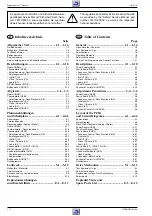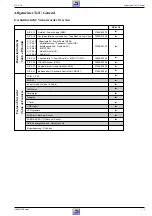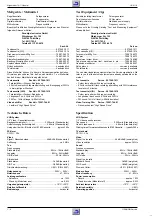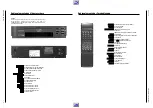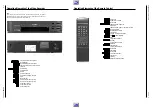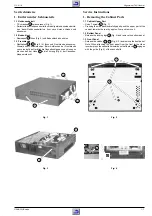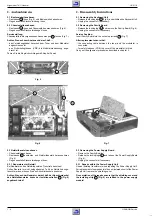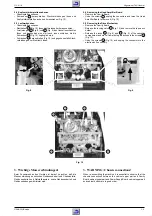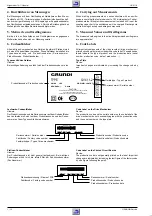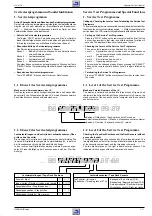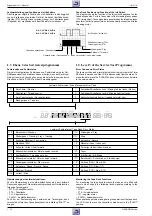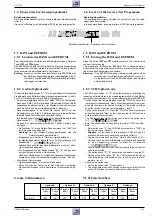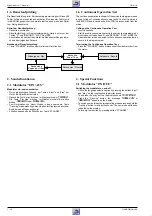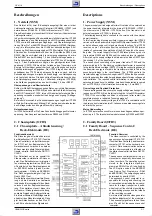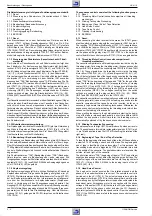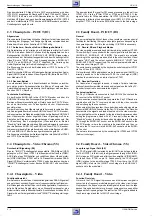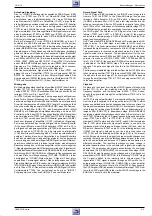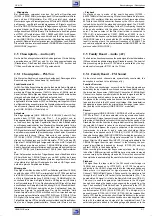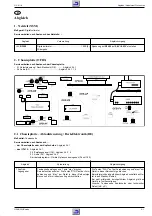
GRUNDIG Service
2 - 1
GV 411-2
Beschreibungen / Descriptions
Beschreibungen
1. Netzteil (NSM)
Das Netzteil ist für zwei IC-Konzepte ausgelegt: Bei einem ist der
Leistungstransistor im Ansteuer-IC integriert (SPH4690 - IC7007) und
beim anderen (TDA4605 - IC7005) ist dieser extern (T7035).
Diese Beschreibung ist beschränkt für die Variante mit dem externen
Leistungstransistor.
ln dem freischwingenden Sperrwandlernetzteil übernimmt der IC7005
die Ansteuerung und Überwachung des MOS-Leistungstransistors
T7035 sowie alle notwendigen Regelungs- und Überwachungsfunk-
tionen. Über Pin 1 erhält IC7005 vom Optokoppler OK7080 (Netztren-
nung!) die Information über die Größe der sekundärseitigen 5,4V-
Spannung. Die Stromversorgung des IC7005 erfolgt an Pin 6 bis zum
Erreichen der Einschaltschwelle über die Widerstände R3054 und
R3056. Nach dem Anlauf wird die Versorgungsspannung über die
Diode D6027 aus der Wicklung 1, 9 des Wandlertrafos gewonnen.
Die Serienschaltung von Leistungstransistor T7035 und Primärwick-
lung 6, 7 des Sperrwandlers liegt an der gleichgerichteten Netz-
spannung (C2070). Während der Leitphase des Transistors wird
Energie im Übertrager gespeichert und in der Sperrphase über die
Sekundärwicklungen abgegeben. Der IC7005 regelt über die Ein-
schaltdauer des T7035 die übertragene Energie so nach, daß die
Sekundärspannungen weitgehend unabhängig von Netzspannung
und Last stabil bleiben. Die dazu nötige Regelinformation wird über
den Optokoppler gewonnen (s.o.). Außerdem erfolgt an IC7005-(8)
eine Nulldurchgangsdetektion aus der Wicklung 1, 9 über R3027.
Überspannungs- und Überlastschutz
Sollten im Störfall Überspannungen auftreten, spricht die Speisespan-
nungsüberwachung im IC7005-(6) an und unterbricht die Ansteuerung
des MOS-Transistors T7035. Ist nach Wiederanlauf weiterhin Über-
spannung vorhanden, wiederholt sich der ganze Vorgang ("Abfrage-
vorgang").
Bei einem Kurzschluß der Sekundärspannungen regelt der IC7005
mittels der Drainstromnachbildung (Pin 2) auf einen sich wiederholen-
den Abfragezustand und begrenzt somit die Leistung.
Netzunterspannung
Im IC7005 arbeitet über Pin 3 eine Schutzschaltung gegen Netzunter-
spannung. Den Ansprechwert bestimmen R3005 und R3007.
Descriptions
1. Power Supply (NSM)
The power supply unit is designed for two IC-versions: One version has
the power transistor integrated in the driving IC (SPH4690 - IC7007),
the other version (TDA4605 - IC7005) has not; the transistor is an
external component (T7035) in this case.
The following description is confined to the version with the external
power transistor.
In this free-running blocking-oscillator type mains stage, the IC7005
carries out the drive and monitoring of the MOS power transistor T7035
and also all necessary control and monitoring functions. The IC7005
receives on pin 1 information from the optocoupler OK7080 (mains
isolation!) concerning the amplitude of the 5.4V supply on the secon-
dary side. The current supply for the IC7005 takes place on pin 6 via
the resistors R3054 and R3056 until the switch-on level is reached.
After start up the supply voltage is obtained via the diode D6027 from
the winding 1, 9 of the transformer.
The series circuit consisting of the power transistor T7035 and the
primary winding 6, 7 of the blocking oscillator transformer is connected
to the rectified mains voltage (C2070). During the conducting phase of
the transistor, energy is stored in the transformer which is fed to the
secondary windings in the cut-off phase. The IC7005 controls the
transferred energy by the switch-on period of T7035 so that the second-
ary voltages are held constant largely independent of mains voltage and
load variations. The required control information is produced via the
optocoupler (see above). In addition, zero transition detection is carried
out on IC7005-(8) by the information from winding 1, 9 via R3027.
Overvoltage and Overload Protection
If an overvoltage condition occurs, the supply voltage monitoring circuit
responds via IC7005-(6) and interrupts the drive to the MOS transistor
T7035. If the overvoltage condition is still present after restart, the
complete process is repeated ("sensing process").
With short circuit secondary voltages, the IC7005, in combination with
the drain current simulation (pin 2), takes up a repeated scanning state
and limits the power.
Mains Undervoltage
In IC7005 a protection circuit for mains undervoltage conditions oper-
ates via pin 3. The threshold value is determined by R3005 and R3007.
2. Family Board (OFB3)
2.1 Family Board – Sequence Control /
Deck Electronic (DE)
Function Overview
The video recorder is controlled by the
sequence control computer IC7410, TVC
(Toshiba Video Controller), and the micro-
computer IC7101 on the keyboard con-
trol unit. Data communication between
the two microcomputers is effected via
the bidirectional serial interface DATD1/
CLKD1.
The sequence control computer is a mi-
crocomputer especially developed for
video recorders. The operating system
stored in the integrated mask-pro-
grammed ROM of the
µ
C is defined by
the VCR option code in the EEPROM
(see Service Test Programme - RAM
and EEPROM). The computing speed is
determined by quartz Q1401.
The sequence control computer is re-
sponsible for driving and checking the
drive mechanism including the servo sys-
tems for the tape transport and head-
wheel control. It controls the record/play-
back switching process and the release
of the recording currents.
An internal black/white video generator
facilitates adjustment of the modulator.
The necessary signals are fed out from
pins 27 and 29 of the sequence control
computer.
2. Chassisplatte (OFB3)
2.1 Chassisplatte – Ablaufsteuerung /
Deck-Elektronik (DE)
Funktionsübersicht
Die Steuerung des Gerätes übernimmt
der Ablaufrechner IC7410, TVC (Toshiba
Video Controller) und der Mikrocompu-
ter IC7101 auf der Bedieneinheit. Der
Datenaustausch zwischen den beiden
Mikrocomputern erfolgt über die bidirek-
tionale serielle Schnittstelle DATD1 /
CLKD1.
Der Ablaufrechner ist ein speziell für
Videorecorder entwickelter Mikrocom-
puter. Das Betriebssystem im integrier-
ten maskenprogrammierten ROM des
µ
Cs wird durch den Geräteoptionscode
im EEPROM definiert (siehe Service-
testprogramm – RAM und EEPROM).
Die Rechnergeschwindigkeit legt der
Quarz Q1401 fest.
Der Ablaufrechner übernimmt die Steue-
rung und die Kontrolle des Laufwerks
inklusive der Servosysteme für den Band-
vorschub und der Kopfscheibensteue-
rung. Des weiteren steuert dieser die
Aufnahme-/Wiedergabeumschaltung,
sowie die Freigabe der Aufsprechströme.
Ein interner Schwarz/Weiß-Bildgenerator
erleichtert den Modulatorabgleich. Dazu
gibt der Ablaufrechner an den Pins 27
und 29 die erforderlichen Signale aus.


